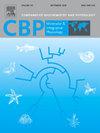巴兰濑鱼(Labrus bergylta)的低温驱动生理反应:应激、炎症和肝脏健康
IF 2.2
3区 生物学
Q4 BIOCHEMISTRY & MOLECULAR BIOLOGY
Comparative Biochemistry and Physiology A-Molecular & Integrative Physiology
Pub Date : 2025-08-18
DOI:10.1016/j.cbpa.2025.111923
引用次数: 0
摘要
摘要本研究探讨了冬季条件对鲑鱼养殖中广泛使用的生物防治剂巴兰濑鱼(Labrus bergylta)生理的影响。鱼被置于冬季和夏季的短期(6、10或14°C的8天)或长期(7或15°C的2.5个月)的温度条件下。然后检查他们的应激、炎症和肝脏反应。短期暴露后,在形态学(体重、总长度、条件因子)、应激标志物(皮质醇、葡萄糖和应激相关基因的头肾表达)水平和炎症标志物(循环脂质炎症介质、cox和lox基因的肝脏表达)方面没有发现显著差异。然而,在6°C时,鱼表现出较低的乳酸水平和增加的头肾cyp11a1表达,表明在热驯化过程中发生了一些代谢和生理变化。相比之下,长期暴露在7°C下导致生长发育迟缓,同时应激标志物水平升高,表明第三次应激反应。此外,长期暴露于7°C显著降低了脂质抗炎介质的水平,特别是由COX合成并从DHA和EPA中提取的脂质抗炎介质,同时增加了头肾中促炎细胞因子il-1β的表达,表明低温下炎症能力增强。此外,7°C下的濑鱼表现出更大的肝体指数和更大的肝细胞,表明能量底物在肝脏中积累和储存。研究结果强调了巴兰濑鱼对冬季温度的生理挑战和适应性反应,为优化养殖实践和提高物种在部署期间的健康、福利和表现提供了重要见解。本文章由计算机程序翻译,如有差异,请以英文原文为准。

Low temperature-driven physiological responses in ballan wrasse (Labrus bergylta): Stress, inflammation, and liver health
Abstract
This study investigated the impact of winter conditions on the physiology of ballan wrasse (Labrus bergylta), a widely used biological control agent in salmon farming. Fish were subjected to temperatures encompassing winter and summer conditions for short-term (8 days at 6, 10, or 14 °C) or long-term (2.5 months at 7 or 15 °C) period. Their stress, inflammatory, and hepatic responses were then examined. After short-term exposure, no significant differences were found in terms of morphology (bod weight, total length, condition factor), levels of stress markers (cortisol, glucose, and head kidney expression of stress-related genes), and inflammatory markers (circulating lipid inflammatory mediators, liver expression of cox and lox genes). However, at 6 °C, fish exhibited lower lactate levels and increased head kidney cyp11a1 expression, indicating some metabolic and physiological changes during thermal acclimation. In comparison, long-term exposure to 7 °C resulted in stunted growth, along with elevated levels of stress markers, indicating tertiary stress response. Additionally, long-term exposure to 7 °C significantly lowered the levels of lipid anti-inflammatory mediators, particularly those synthesized by COX and derived from DHA and EPA, while increasing the pro-inflammatory cytokine il-1β expression in the head kidney, suggesting a heightened inflammatory capacity at low temperatures. Moreover, ballan wrasse at 7 °C displayed a larger hepatosomatic index and enlarged hepatocytes, indicative of energy substrate accumulation and storage in the liver. Findings highlight the physiological challenges and adaptive responses of ballan wrasse to winter temperatures, providing crucial insights for optimising farming practices and enhancing species' health, welfare and performance during deployment.
求助全文
通过发布文献求助,成功后即可免费获取论文全文。
去求助
来源期刊
CiteScore
5.00
自引率
4.30%
发文量
155
审稿时长
3 months
期刊介绍:
Part A: Molecular & Integrative Physiology of Comparative Biochemistry and Physiology. This journal covers molecular, cellular, integrative, and ecological physiology. Topics include bioenergetics, circulation, development, excretion, ion regulation, endocrinology, neurobiology, nutrition, respiration, and thermal biology. Study on regulatory mechanisms at any level of organization such as signal transduction and cellular interaction and control of behavior are also published.

 求助内容:
求助内容: 应助结果提醒方式:
应助结果提醒方式:


